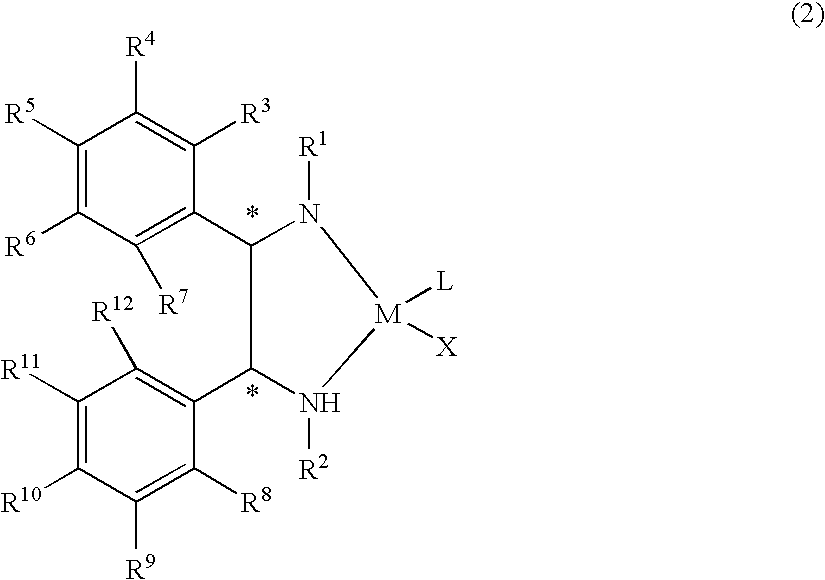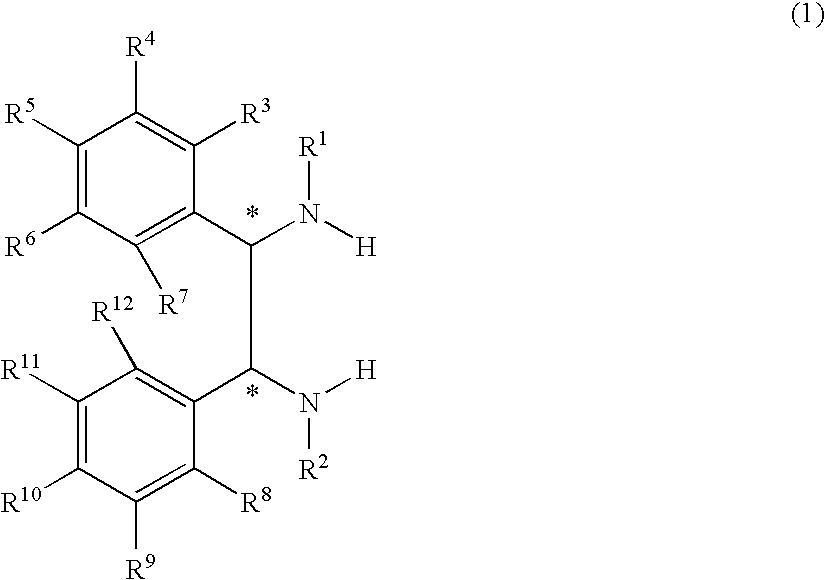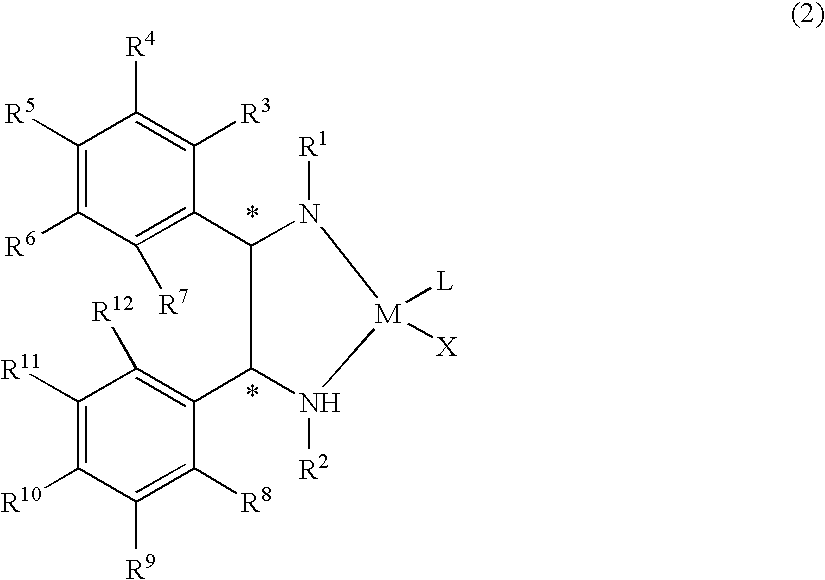Optically active transition metal-diamine compound and process for producing optically active alcohol with the same
a transition metal and compound technology, applied in the direction of organic compound/hydride/coordination complex catalyst, physical/chemical process catalyst, ruthenium organic compound, etc., can solve the problems of unavoidable separation of catalyst and product, document does not disclose any method for recovering a catalyst dissolved in water or reuse, and achieves easy recovery, high yield, and clean chemical reaction
- Summary
- Abstract
- Description
- Claims
- Application Information
AI Technical Summary
Benefits of technology
Problems solved by technology
Method used
Image
Examples
example 1
Synthesis of 1,2-di(4-N,N-dimethylaminophenyl)ethylene-1,2-diamine
(1) Synthesis of di 4-N,N-dimethylbenzoazine
[0285]To a mixed solution of 10.4 g (0.08 mol) of hydrazine sulfate and 78 mL of water was added 8.9 g (0.1464 mol) of 28% ammonia water, and the resultant solution was heated. Next, to this solution was dropwise added 80 mL of tetrahydrofuran (THF) solution of a 26.76 g (0.179 mol) of 4-N,N-dimethylaminobenzaldehyde at 40° C. or lower taking 2 hours or more, and the solution was further reacted with stirring at the same temperature for 2 to 3 hours. To the reaction solution was added 28% ammonia water to make the water layer alkaline. Thereafter, 100 mL of toluene was added thereto and the resultant was cooled to 10° C. The precipitated yellow solid substance was filtrated off, and was washed with toluene and water in sequence. In addition, the solid substance obtained from the organic layer of the filtrate was washed with water and toluene in sequence. The solid substances...
example 2
Synthesis of Monobenzenesulfamide of (1R,2R)-1,2-di(4-N,N-dimethylaminophenyl)ethylene-1,2-diamine
[0295]To a mixed solution of 50 mg (0.167 mmol) of (1R,2R)-1,2-di(4-N,N-dimethylaminophenyl)ethylene-1,2-diamine obtained in Example 1, 17.7 mg (0.1752 mmol) of triethylamine and 1 mL of dichloromethane was added a solution of 28.1 mg (0.1593 mmol) of benzenesulfonyl chloride in 1 mL of dichloromethane in such a manner that at intervals of 15 minutes a volume of 0.05 mL was added at each time under cooling with ice. Thereafter, the solution was further reacted with stirring at the same temperature. The reaction solution was poured into water to terminate the reaction. Thereafter, sodium carbonate was added thereto to make the solution alkaline. And then, the dichloromethane layer was separated, washed with water, dried over anhydrous magnesium sulfate, and then concentrated to give 73.9 mg of crude monobenzenesulfamide of (1R,2R)-1,2-di(4-N,N-dimethylaminophenyl)ethylene-1,2-diamine. HP...
example 3
Transfer hydrogenation of acetophenone using monobenzenesulfamide of (1R,2R)-1,2-di(4-N,N-dimethylaminophenyl)ethylene-1,2-diamine and [RuI2(mesithylene)]2
[0301]To a mixed solution of 4 mg (0.0098 mmol) of monobenzenesulfamide of (1R,2R)-1,2-di(4-N,N-dimethylaminophenyl)ethylene-1,2-diamine, 1.86 mg (0.0032 mmol) of [RuCl2(mesithylene)]2, 0.45 mg (6.7 mmol) of sodium formate, and 4 mL of water was added 0.2 g (1.66 mmol) of acetophenone, and the solution was reacted with stirring at 50° C. for 2.5 hours. As a result, it was confirmed that an alcohol was given with a conversion ratio of 97.9% and a selection ratio of 99.62%.
[0302]The pH of the water layer was 8.4 at the time of the end of the reaction. To the reaction solution was added 76.4 mg (1.66 mmol) of formic acid to make the solution into an acidity (pH=5.5). Thereafter, the product was extracted with heptane (the separated water layer was reused in the next reaction). The heptane extracted solution was washed with water, dr...
PUM
| Property | Measurement | Unit |
|---|---|---|
| reaction temperature | aaaaa | aaaaa |
| reaction temperature | aaaaa | aaaaa |
| reaction time | aaaaa | aaaaa |
Abstract
Description
Claims
Application Information
 Login to View More
Login to View More - R&D
- Intellectual Property
- Life Sciences
- Materials
- Tech Scout
- Unparalleled Data Quality
- Higher Quality Content
- 60% Fewer Hallucinations
Browse by: Latest US Patents, China's latest patents, Technical Efficacy Thesaurus, Application Domain, Technology Topic, Popular Technical Reports.
© 2025 PatSnap. All rights reserved.Legal|Privacy policy|Modern Slavery Act Transparency Statement|Sitemap|About US| Contact US: help@patsnap.com



